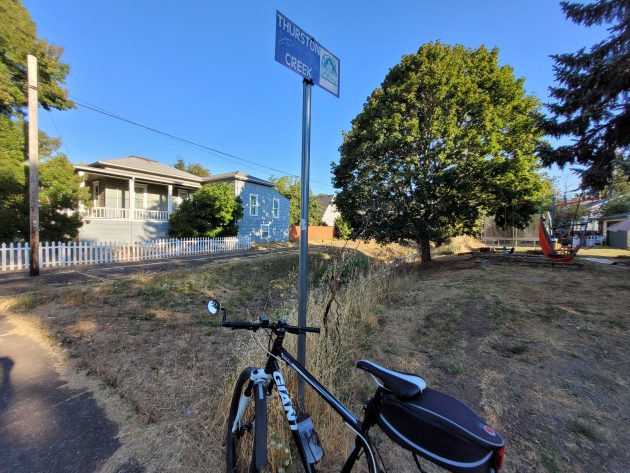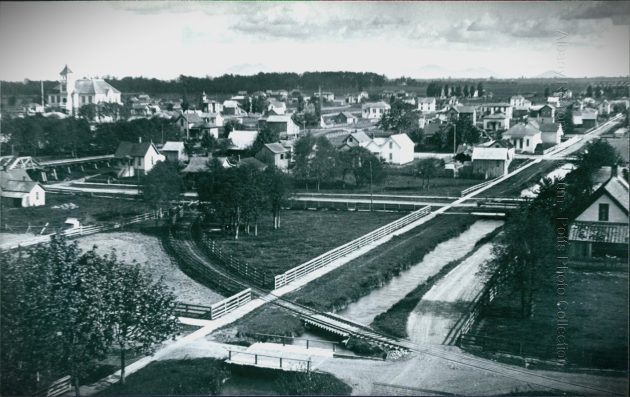
The city’s sign calls it a creek, but at this point the Thurston Street Canal is hardly more than a mud-filled ditch.
It’s a shame what has happened to one of Albany’s canals, the one that runs down Thurston Street from Seventh Avenue to the Willamette River.
In the late 1800s, this canal was 10 or 12 feet wide and carried enough water to power the turbines of more than a dozen industries on the riverfront.
Conditions changed during the century that followed as the industries disappeared. The canal became a pain to maintain, but by the 1970s it was still a functioning waterway where neighborhood kids could catch crawdads and even juvenile trout.
In 1978, the City of Albany received a federal block grant for several projects. One was to close Thurston Street on either side of the canal and to landscape the space with trees and shrubs and a pedestrian pathway. This was accomplished in 1981.
Then the city planned to to build a massive storm sewer 20 feet below the canal — and 5 feet in diameter — to drain a vast industrial area south of what were then the Southern Pacific tracks. If neighbors wanted the canal rebuilt above the storm sewer, they were told they would have to pay for it.
The neighbors objected, and on June 29, 1983, instead of planning to bill adjacent owners an estimated $2,500 each, the city council agreed to rebuild the canal at city expense.
A year later, in the spring of 1984, the storm sewer contractor returned to rebuild the canal. The local paper said it would be a concrete ditch 5 feet deep to hold about a foot of water.
Now, the ditch is still there. But it appears to have silted up, and there’s barely a trickle of water running down it, just enough in places for water striders to skitter back and forth.
The water in the ditch comes from the Eighth Avenue Canal, which in turn is fed from the Albany Santiam Canal. One question: Where does the water from Eighth Avenue go, for there’s almost none on Thurston Street?
Over the years, starting with a landscape architect’s master’s thesis in 1977, there have been suggestions for making better use of Albany’s canals including Thurston Street. The most recent proposal to do so was part of the 2001 downtown urban renewal plan.
As you can see on Thurston Street, and along the Santiam Canal as well, the ideas have not been carried out because they generated no public support. But maybe it’s not too late. (hh)

Here on Eighth Avenue, you can see what could be done with Albany’s other canals.

This is the Thurston Street Canal south of Fourth Avenue the way it looked on Aug. 25, 2022.

The Thurston Street Canal around 1900, from the Robert Potts photo collection put online by the Albany Regional Museum. First Avenue runs across the middle of the frame to the still-existing trestle at left.



I learned to drive in a VW bug driving up and down the sides of Thurston back in the late 60’s. Kids did catch tiny trout at 5th and Thurston. There were parts where it was too wide to jump across the water, and it was more of a natural creek.
It is criminal to let such unique and historical features of our city disappear
I would guess there is public lack of interest due the City of Albany to attempt to more actively involve its citizens
The Thurston Street Canal provided the hydropower for the Red Crown Mill located at the foot of Thurston Street near the River. The mill was destroyed by fire almost 60 years ago.
More like Apathy towards this area of town. We are neither downtown or the waterfront or in the fancy new area on the other side of the rail tracks. Living one block from where the canal disappears. It would be nice to have a unique cared for historic interesting feature back. Many people walk between first and second on Thurston on their way to the river.What we get to see when we walk is a weedy old field, a vacant drug house with druggies sleeping in the tall grass-now cut, trash from those walking between the two local bars late at night, numerous feral cats that the city refuse to help control and trash from homeless druggys sleeping in the shadows of Kantons as they wait for helping hands to open or on the porch of the abandoned house.
Mosquitoes breed in stagnant water. Either give it a good flow or shut it down.
If this is water diverted from the Santiam and is not natural, useful, or needed the flow should be blocked and left in the Santiam where it belongs.
Agree with all of this and hope that a new momentum can be found.
Thurston Creek is not always that low, though. It often comes up into the reeds and is a home for duck families…
So, there’s a nostalgic attachment for waterways that no longer support themselves.
There’s little positive attachment for refurbished old buildings that produce income.
Seems to jealousy of the developers and owners for daring to make money
Just came back from trip to upstate NY where I visited gate 1 of the Champlain Canal.
The NYS Canal System was opened for traffic in 1825 so it is nearly 200 years old; an engineering masterpiece bringing commerce and communities to populate upstate and connect with the Great Lakes along it’s 801 miles. That is a major canal.
some of these man made canals are risking destroying the Great Lakes fishery (which is worth billions) by introducing invasive species.